Echinocactus Gruzona: description, types and care
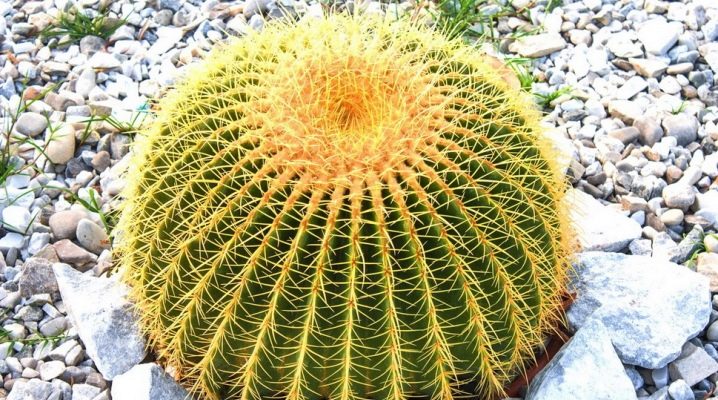
Cacti are some of the favorite indoor plants because they are easy to care for. Echinocactus Gruzon is found in different varieties, however, the requirements for its cultivation are always the same.
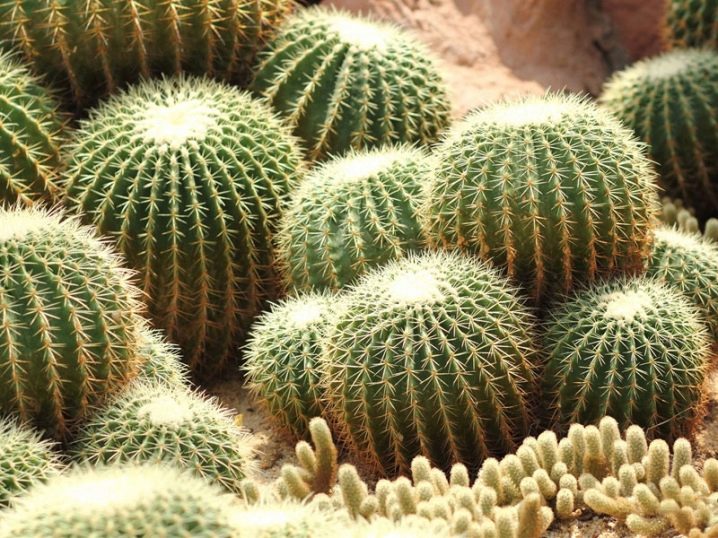
Peculiarities
Echinocactus Gruzon - it is a globular succulent from the Cactaceae cactus family. Succulents are plants that have special tissues that allow them to retain moisture in arid climates. Succulents can store liquid in leaves or shoots.
Most of the species that currently belong to the family of these plants are stem succulents. According to the Brockhaus and Efron encyclopedia, there are about 200 types of them... They all grow from the southwestern United States to Brazil. The Great Soviet Encyclopedia is limited to a description of only ten varieties.
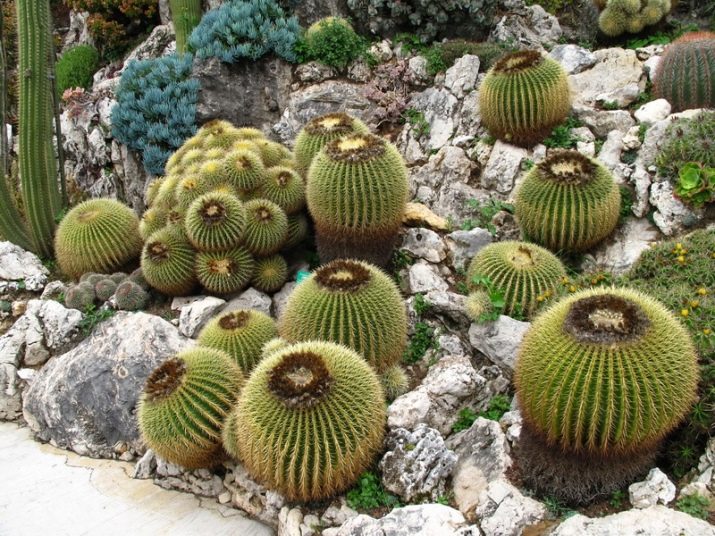

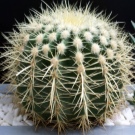

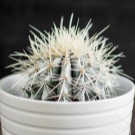

The homeland of the cactus is Central Mexico. In the common people, this plant is also called a hedgehog, since on its surface there are needles in the form of bristles. The plant is especially popular among exotic lovers. German scientist, inventor and industrialist Hermann Gruzon, who lived in the 19th century, had the largest collection in Europe, which he later donated to the city of Magdeburg.
Echinocactus grows up to 80 centimeters wide and 130 centimeters high. It has up to three dozen ribs, there are hard amber spines up to 5 centimeters long, as well as yellow or pink flowers up to 6 centimeters long. A mature plant blooms infrequently (in summer) and all year round "wears" a crown of golden hair on the top. Each flower stem develops a fruit with a scaly surface and black seeds.

Bright yellow cupped wide flowers emerge from the halos on the crown of mature plants, but since echinocactus does not bloom until fully ripe, flowers of this size have never been seen in indoor specimens. In areas with mild winter temperatures, this species can be successfully grown outdoors and, under good conditions, can grow old enough to flower. The plant's lifespan is estimated at 30 years.
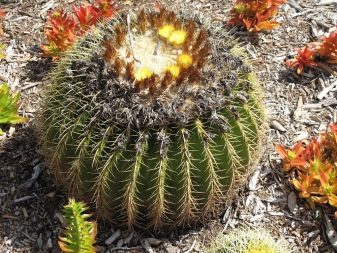
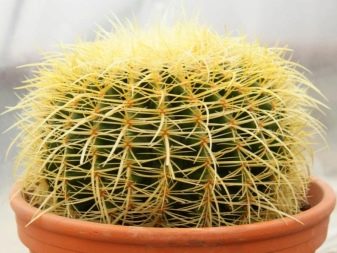
Varieties
Often, when buying a store plant, you can find many additives to the name, for example, "Rainbow" or "Red". In fact, this is all just a gimmick. Novice growers are deceived by an attractive name, but in reality this is the same cactus that was just dyed. In the best case - food coloring (red, purple, yellow, pink), and in the worst case - they used dyes from the printer.
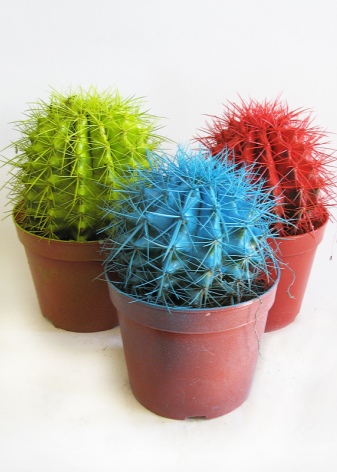
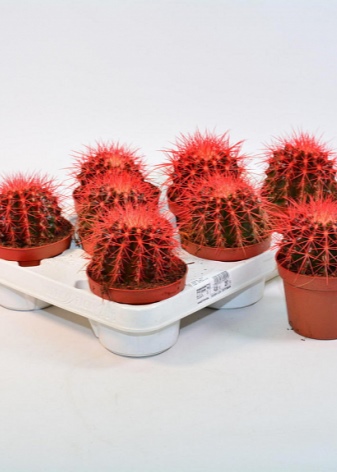
Do not be fooled, in fact, Gruzona's cactus has spines of a very light yellow or even white color. Over time, this shade will return.
If we talk about the types, then the following stand out among them.
Flat-spiked
It can be up to two meters long and one and a half meters wide. Of the distinctive features, a small number of edges stand out. The spines on the described species are gray, not bent. In Mexico cactus is actively used in the preparation of sweets, so at one time it was even on the verge of extinction.
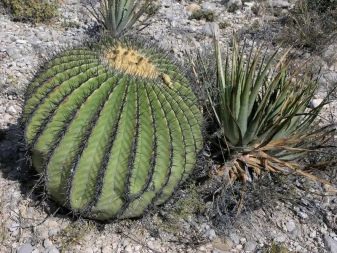

Bet
At first it looks like a ball, then it changes shape to cylindrical. At only 35 centimeters high, the spikes not only bend, but also have an attractive pink color.Growing at home is not easy, the variety has many requirements for care. Seeds germinate poorly, the plant itself has a weak immunity to disease.
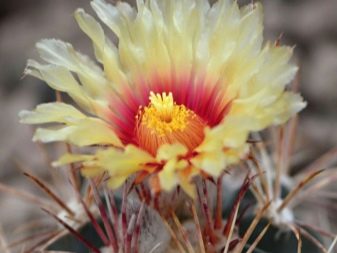
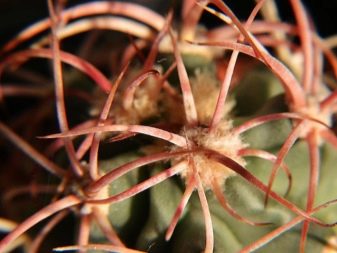
Horizontal
It is difficult to confuse him with his fellows, since he is very different from them in shape. The outline resembles a ball, while the edges are twisted in a spiral. Even in adulthood, such a cactus has a diameter of no more than 30 centimeters. The spines are quite thick, with a bright red hue. If we compare it with other echinocactus of Gruzon, then it is easier to achieve flowering at home from this.
After blooming, the flower becomes lilac-pink, up to 3 centimeters in diameter.
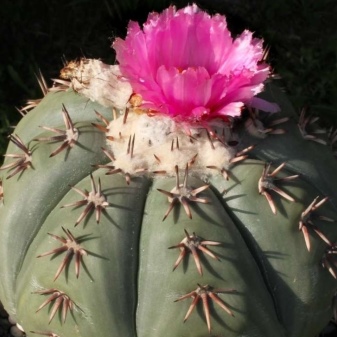
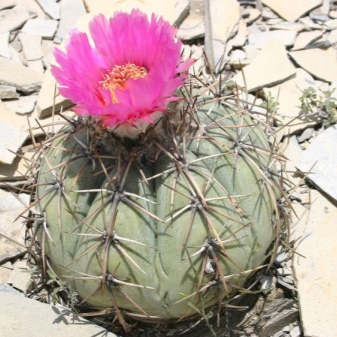
Wide-necked
It is difficult not to pay attention to this species, since a huge number of thorns are formed on its surface, the length of which can be up to three centimeters. When the plant blooms, on its surface appear flowers are yellow, resembling a funnel.
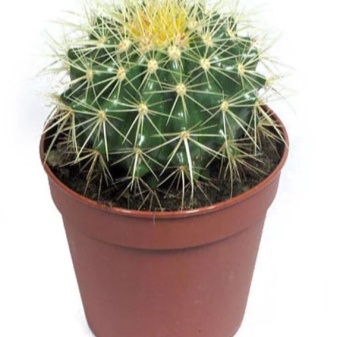
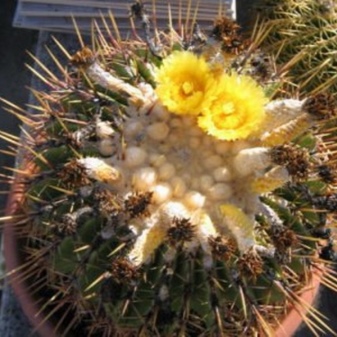
Multi-headed
This is the only variety that can please flower growers with needles of different colors. They may be pink, red, purple and other shades. In indoor conditions, the height of a cactus can be 70 cm, there are few thorns on the ribs.

Polycephalus
Highly looks like a real hedgehog thanks to the numerous thorns. Usually it grows in groups, sometimes the number of such cacti reaches one hundred copies. The characteristics are similar to the previous species.

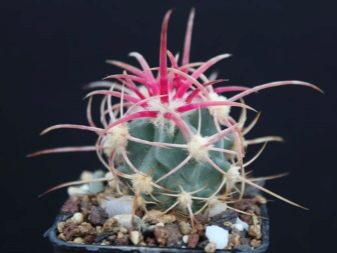
Conditions of detention
The best keeping conditions for the described cactus are warmth, sun, good ventilation, relatively small temperature differences. The plant can grow with equal success both indoors and outdoors.
Fertilizers are regularly used from late spring to mid-summer. Starting in August, fertilizing is applied less frequently to prepare the plant for a period of complete dormancy. Since March, feeding is gradually resumed, a weak solution of the complex mixture can be introduced.
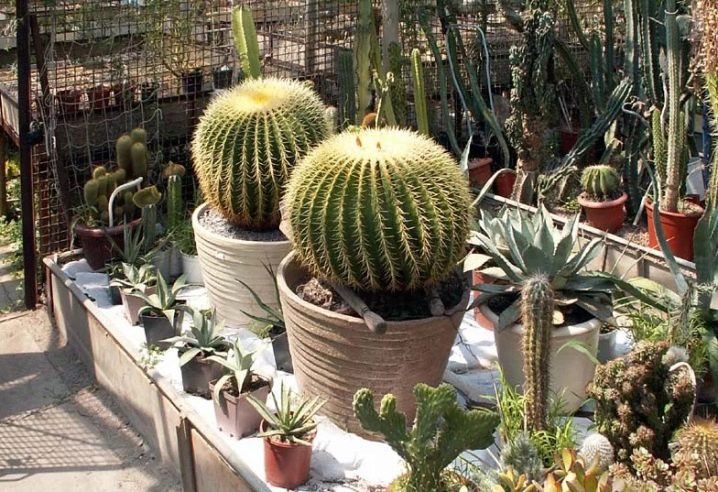
Lighting
The plant feels great in bright light. There is no need to protect it from direct sunlight, unlike most indoor flowers. It is best to place the cactus on a south or west window. However, it is not necessary to expose the plant to a lot of sun immediately after the mandatory rest period from October to April.
This period should be cool for him.

The quality and health of the thorns immediately shows whether the plant has enough light or is deficient in it.
Temperature and humidity
During the period of active growth, a warm room temperature is usually suitable for a cactus. During the dormant winter period, it should be kept at a temperature of about 10 ° C. The minimum permissible temperature is approx. 5 ° C. At a lower surface, the plant may discolor, brown spots appear.
On the other hand, if the air temperature in the room is much higher than 12 ° C, the plant will strive to continue growing, and often, in low light, it acquires a spherical shape, sometimes it lengthens unevenly, and therefore looks ugly.
To avoid this, you need to give it artificial light; fluorescent or fluorescent lamps are ideal for this.
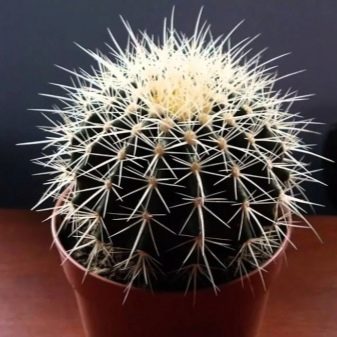
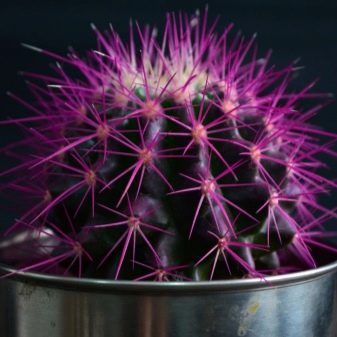
As for the humidity level, then cactus perfectly withstands drought... In the room, there is enough indicator of 50-60% for the flower to feel comfortable; if the humidity is too high, the cactus begins to rot. It is impossible for a draft to be nearby, it also negatively affects the health of the plant.
The soil
The potting mixture used for cactus plants must be well drained and light. Echinocactus does not like dense soil, in which there is little oxygen and from where moisture slowly evaporates. It helps to improve the quality of the ground by adding gravel or small pebbles to the bottom. Perlite and vermiculite will also help remove excess water from the soil. As a basis, prepare slightly acidic soil with pH 5.0-6.0.
It should be well-drained, consisting of loam, leaves, peat and coarse sand in the following proportion: 2: 1: 1: 1. It is allowed to add a small amount of humus and brick chips.
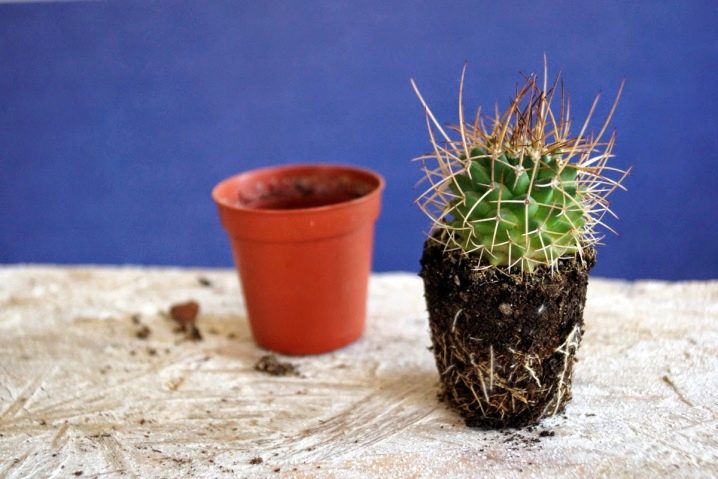
All components, although purchased from a specialist store, needs to be disinfected, this also applies to the ground. To do this, it is placed in an oven for an hour and heated to a temperature of 80 ° C, but no more. If it is overheated, then not only bacteria will die, but useful substances will also be destroyed.
As for expanded clay, some growers add it as a material to create drainage. Recent research by scientists has shown that it is often the reason that potting soil becomes brushed so quickly. It is harmful to use in large quantities and foam crumbs. It helps keep the roots from dropping in temperature, but does not allow moisture to pass through if used in a thick layer.
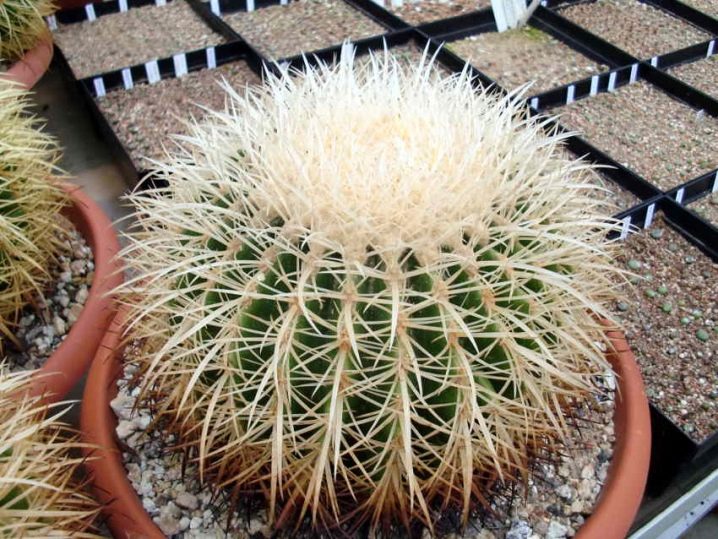
How to care?
Remember and follow the general rule of growing cacti: it is better not to top up than to overflow. It is very often possible to observe how black rot develops in an echinocactus flooded with water. The same will happen if the grower uses a pot with poor drainage.
Experts advise to wear thick gloves when working with cacti, because the injection can be not only painful, but also carry the danger of infection. It is very important to know that these flowers do not tolerate proximity to violets, as their pollen is harmful to them.
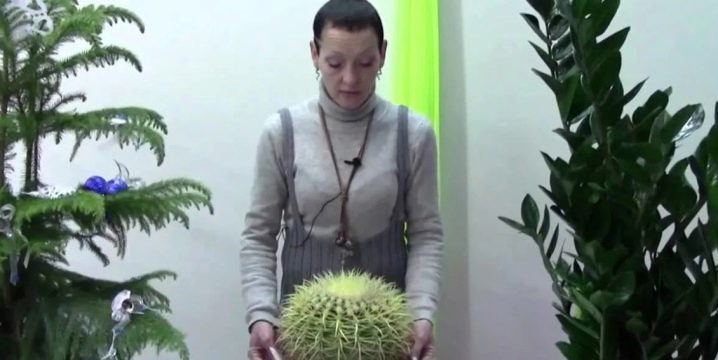
Top dressing
This is not to say that Echinocactus is very picky about feeding, but it still needs it from the beginning of the vegetative period, because over time, all minerals and vitamins are simply washed out from the soil, where high-quality drainage is organized. Instead of regularly applying liquid fertilizers the best idea is to include long-term organics with slow decay. They introduce food in the spring, however, do not use it before and immediately after transplanting.
Mixtures with a high phosphorus content are best suited; the second most important trace elements are potassium and calcium.
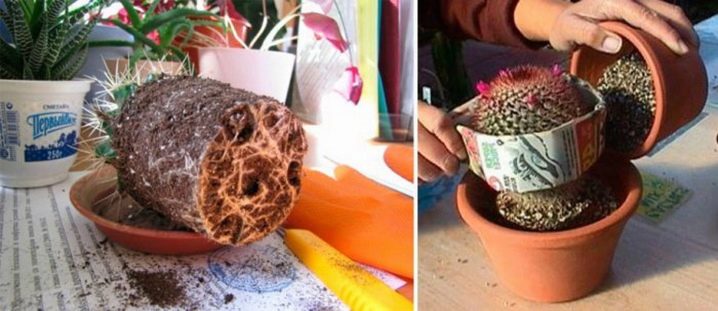
Watering
During the period of active growth (until about mid-August), water should be supplied in sufficient quantities, but not excessively, so as not to flood the soil. In other words, the soil should not be allowed to dry out and be watered. A well-defined schedule will help to organize high-quality and timely watering. Gradually reduce the amount of water and completely stop watering the plant by October.
In winter, the soil must be completely dry, otherwise rotting at the base of the plant is inevitable. The lower the ambient temperature, the less water the flower needs and the longer the soil stays wet, which it shouldn't. Water is applied with caution no more than once every 7-10 days only if the room temperature exceeds 15 ° C.
Avoid wetting the plant body, as liquid can penetrate through microcracks and cause rotting.
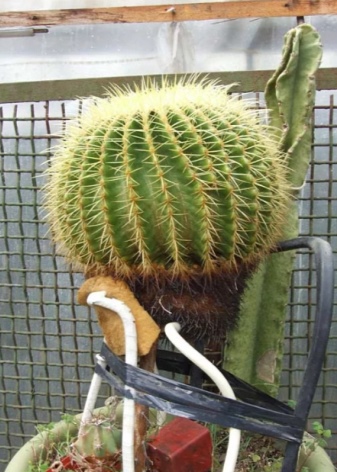
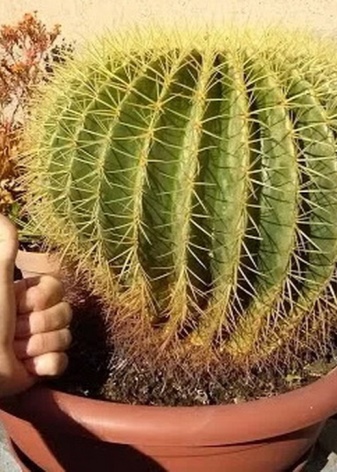
Transfer
It is not worth replanting a cactus immediately after purchase, any houseplant must first acclimate to new conditions before transferring such stress. Some experts say that you can safely carry out the procedure in a year, others advise not to linger and change the pot in a month. In any case, it is worth taking into account the season, the condition of the cactus and other risk factors.
Some experts recommend avoiding replanting cactus altogether due to the fragility of its roots. But, be that as it may, over time, the roots will begin to go beyond the pot, not only from above, but also to penetrate the drainage holes, and you still have to change the capacity. Ideally, the plant should be transplanted in early spring. Young plants are moved to a new container annually or once every 2 years, older ones - as needed or once every 4-5 years.
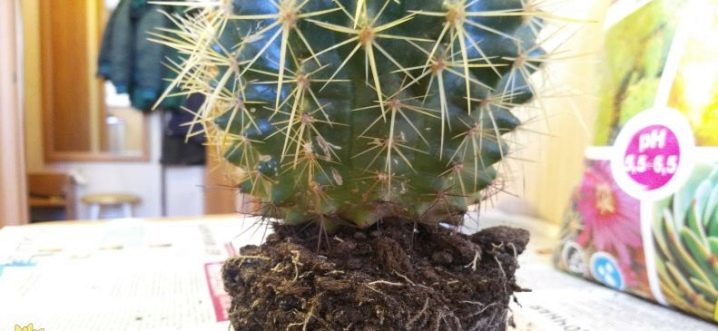
Use a wide pot with special attention to good drainage.To help the plant develop stronger thorns, use old lime peel or eggshells as a source of calcium. Finally, sprinkle the root collar with sand. It is important to ensure that air can easily penetrate to the roots.
Reproduction
The cactus propagates exclusively by seeds. The difficulty lies in the fact that they germinate very poorly, so it is not always or not the first time that it is possible to achieve the desired result. The step-by-step process looks like this.
- When the seeds are ripe they are collected and allowed to dry slightly. Always use fresh planting material to maximize the chances.
- Seeds can be soaked for several hours in warm water or a growth activator.
- Then they are placed in a nutritious soil. from sphagnum moss and covered with foil, creating greenhouse conditions.
- Occasionally you will have to ventilate the planting, otherwise mold may form.
- Into the ground in separate pots transplanted when the first few leaves appear.
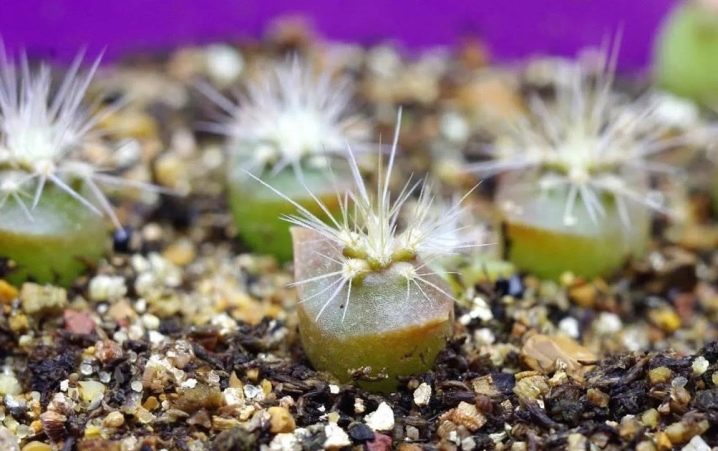
Diseases and pests
Among the most common diseases are root rot and rust. Both diseases are fungal, therefore they respond well to fungicide treatment. In the case of root rot, you will additionally need to change the container, soil, cut off the root system. You can't use your old pot unless you treat it with a mild bleach solution.
Of the insects that like to eat cacti, dangerous are nematode, spider mite, less often aphids... They can be dealt with with neem oil, insecticidal soap, or simply pour warm water over the flower from the shower.
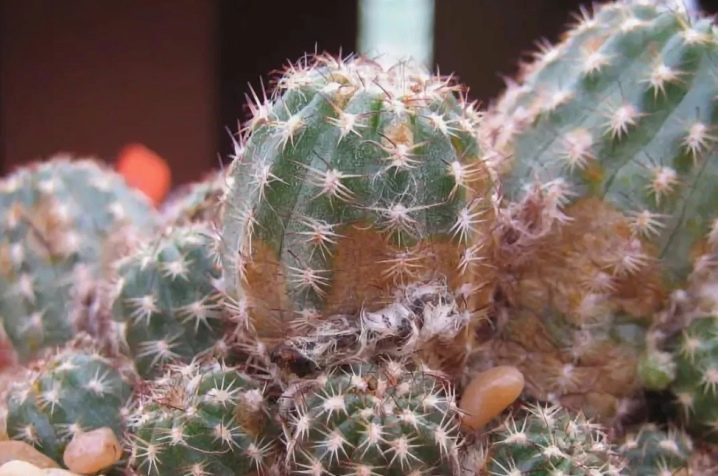
For information on how to properly care for Gruzon's echinocactus, see the next video.























































The comment was sent successfully.